Affiliate disclosure: This post may contain affiliate links. Please see our Privacy Policy.
Elecampane tincture is used by herbalists to as a natural cough remedy, and it’s one of my favorite herbal cough remedies. The root is tinctured for respiratory support, and it’s commonly used for chest congestion, cold/flu, bronchitis and asthma. It’s also been shown to have antimicrobial benefits, and it’s used topically to treat yeast infections and athletes foot.
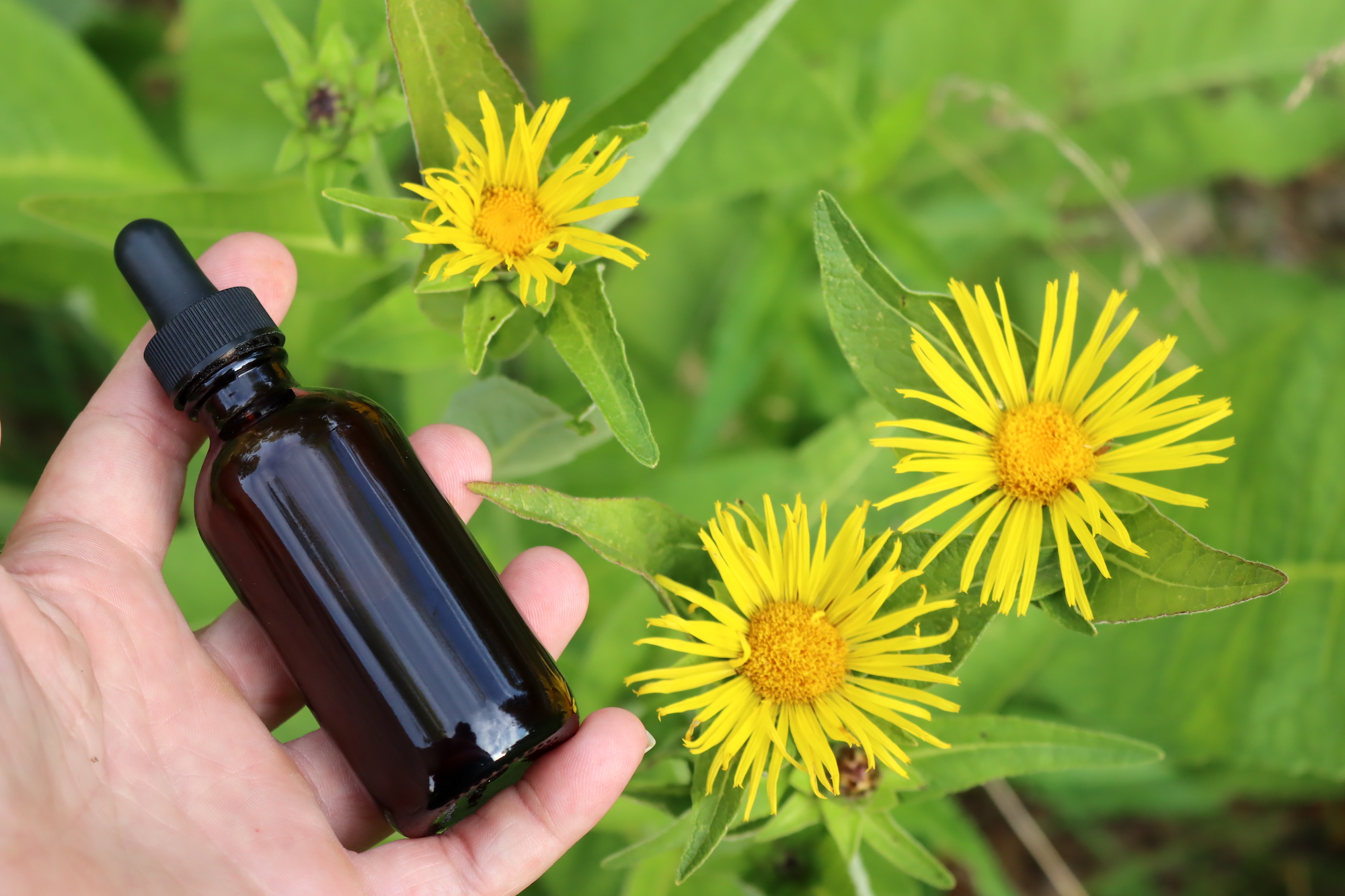
Elecampane is one of those herbal remedies that’s been around (and commonly used) for millennia. Supposedly, Helen of Troy was out gathering elecampane when she was taken, sparking the Trojan war. The woman whose beauty launched a thousand ships thought it important enough to gather elecampane from a hillside herself, and I can only imagine the sick friend of relative she valued waiting back in a sick bed in ancient Greece.
Not just an ancient remedy, elecampane is my go to remedy for cough and congestion, and we mix elecampane tincture with raw honey to make an incredibly effective cough syrup.
It’s one of the herbal remedies that is ALWAYS in my herbal medicine cabinet, and it’s used more than almost any remedy in my herbal first aid kit.
Elecampane grows wild on our land, and it has fluffy airborne seeds similar to dandelion, so it sprouts up all over the place. The plants are 6 to 10 feet tall, with bright yellow daisy like flowers that are hard to miss. The root is what’s used medicinally, and it grows a spicy, aromatic taproot with a wonderful warming flavor.
(Here’s how to identify elecampane in the wild.)
If you don’t grow elecampane (or forage it in the wild) you can buy dried elecampane root online, or ready made elecampane tincture. It’s also a common ingredient in chest care tinctures and lung care tinctures. This is the basic process for making elecampane, but if you’re looking for more details, I’d recommend the Herbal Academy’s Tincture Making Course which covers everything you could ever want to know about making more than 100 different herbal tinctures, as well as half a dozen tincturing methods.
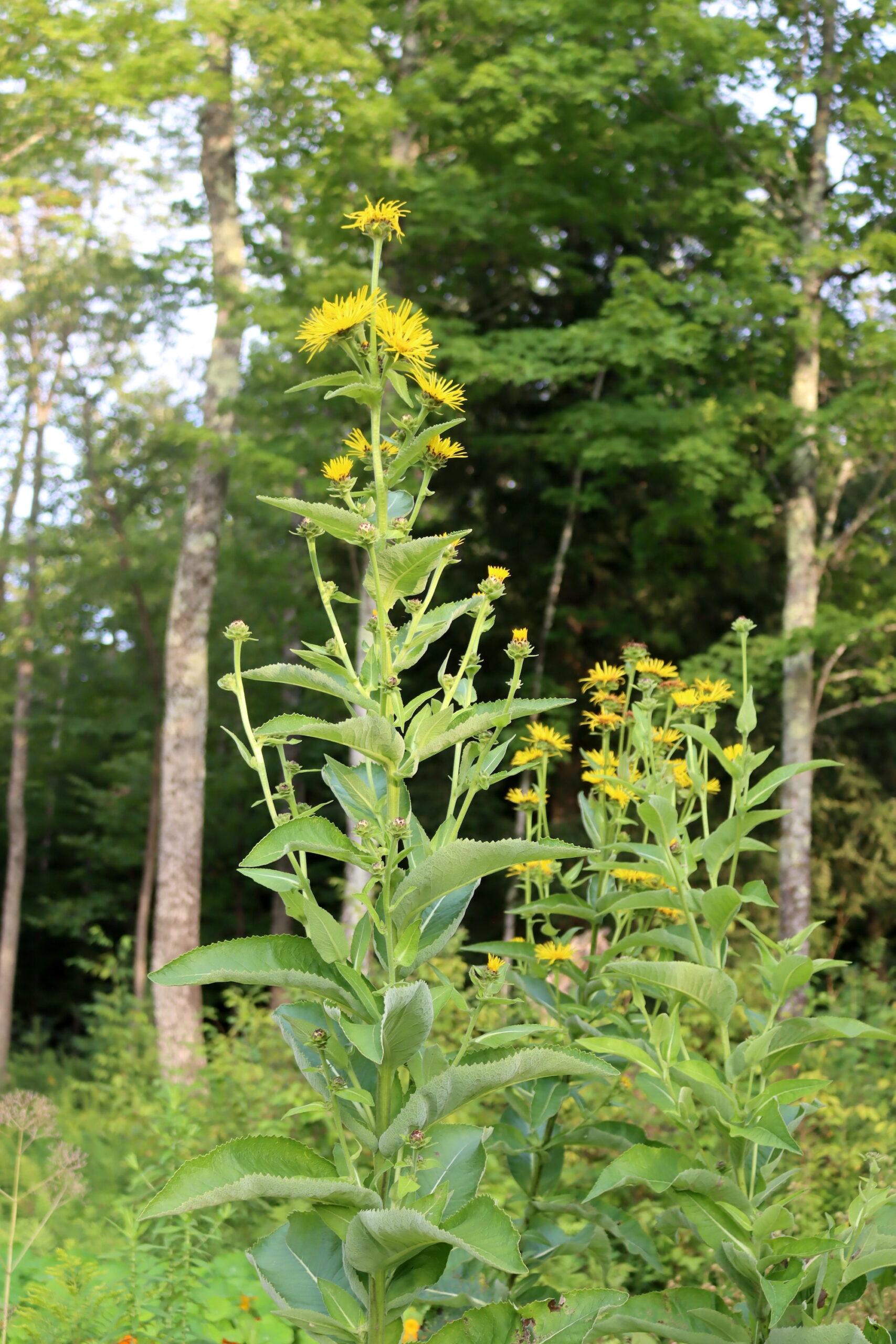
(Always consult your doctor or a clinical herbalist before trying any new herbal remedy, as there’s always the possibility of unintended consequences, allergic reaction, or interactions with other medication. If you’re harvesting wild plant material, make sure you’re 100% confident in your identification and consult multiple sources for your ID. The following is based on my research and experience, but I don’t claim to have any certifications that would qualify me to advise you on your health. Please do your own research and always verify with multiple reputable sources.)
Benefits of Elecampane Tincture
Elecampane is a medicinal herb that is known for its ability to relieve symptoms of lung diseases such as asthma, whooping cough, and bronchitis. Elecampane offers a multi-pronged attack against these illnesses, acting as a cough preventative as well as an expectorant that helps clear the lungs of excess phlegm.
Elecampane tincture is considered both warming and drying, which means its most effective when used to combat wet coughs or mucus that has hardened in the lungs.
Research on the chemical compounds found in elecampane has shown the plant has a wide variety of medicinal properties including antibacterial, anti-inflammatory, anti-fungal, and antimicrobial benefits.
Elecampane tincture can also be applied externally for its anti-candida (yeast) properties and can be used to soothe fungal infections such as athlete’s foot.
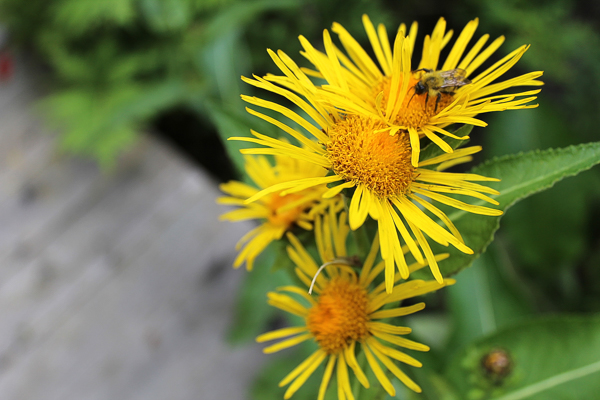
How to Make Elecampane Tincture
To prepare elecampane tincture, gather the following ingredients and supplies:
- Fresh or dried elecampane root
- Vodka (or any other neutral, palatable alcohol with at least 80 proof/40% alcohol content—Smirnoff works well for me as it’s affordable and flavor-neutral)
- A one-pint mason jar with a tight-fitting lid (amber glass is best, but as long as you protect the tincture from light, any jar will work)
- Funnel
- Cheesecloth
- Fine mesh strainer
- Amber glass tincture bottles (preferably with droppers)
Note on Alcohol: The Herbal Academy recommends using 40% alcohol for tincturing elecampane, as it contains both alcohol-soluble and water-soluble compounds. For herbs that are more mucilaginous, they suggest 25% alcohol, while plant resins require a higher concentration of alcohol, up to 95%.
Important Reminder: Never use isopropyl or rubbing alcohol for tinctures, as it’s toxic when ingested. If you prefer to avoid alcohol, consider making an herbal glycerite or herbal vinegar, which also work well with elecampane.
Start by filling the mason jar about 3/4 full with fresh elecampane or about halfway with dried elecampane. Pour the vodka (or your chosen alcohol) over the herb, ensuring it is fully covered. Seal the jar with the lid, and place it in a cool, dark location. Give the jar a gentle shake every few days, or at least once a week, to help with the infusion process.
After 4 to 6 weeks, it’s time to strain the tincture. Line a funnel with a few layers of cheesecloth, then carefully pour the tincture into amber glass bottles, using a fine mesh sieve if necessary to catch any larger particles. Squeeze the cheesecloth to extract all the liquid from the herb.
Once the tincture is strained, label the bottles with the date and suggested dosages. I like to use masking tape and a marker for labeling, which can be easily removed when you’re ready to repurpose the bottle.
For more information on the general process, I’d suggest reading this guide to making herbal tinctures at home.
I know 4-6 weeks can be a long time to wait if you’re desperately needing relief now. There’s nothing wrong with buying a bottle of ready made elecampane tincture to use while your homemade tincture infuses. Purchased tinctures are a lot more expensive than DIY homemade ones, but they have the benefit of being ready when you need them, like now.
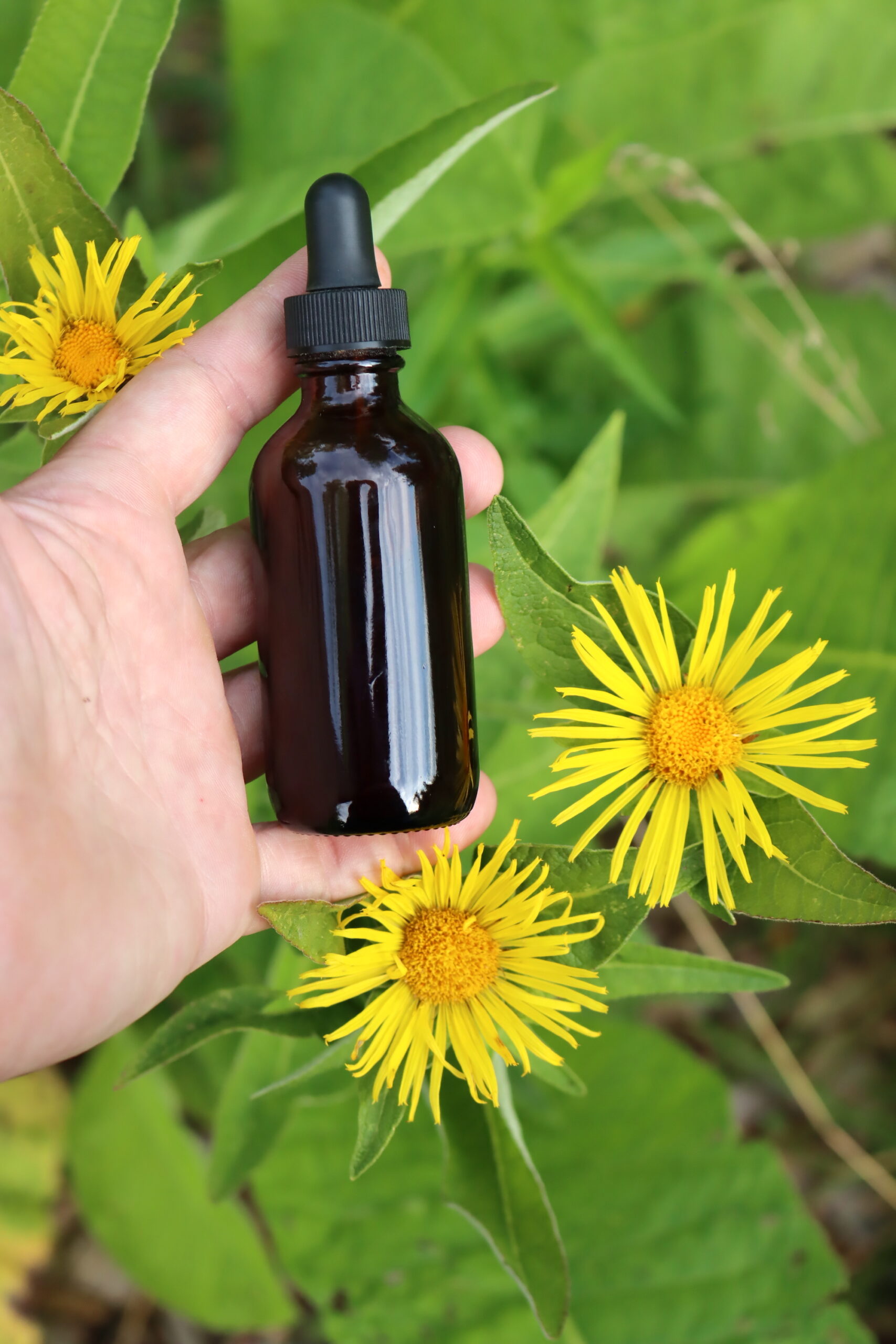
Elecampane Tincture Dosage
For an exact dosage specific to your body and needs, I’d suggest consulting a clinical herbalist.
Generally, the dosage for elecampane tincture is 1 to 2 droppers full, taken 2 to 3 times per day, or as needed. This herb is generally considered safe for use, even at higher doses, and we tend to mix elecampane tincture with raw honey in a 1:1 ratio, making an effective herbal cough syrup that I take every few hours as needed when I’m suffering from a particularly bad cough.
It’s even more effective, I find, when you make it with thyme tincture and elecampane tincture together.
Elecampane Formulations
Elecampane is commonly paired with other herbs for respiratory support, such as Usnea, Licorice and Thyme.
This chest care tincture uses elecampane mixed with ginger, horehound, licorice, marshmallow and mullein. Similarly, this lung care tincture combines elecampane with many of the same herbs.
Personally, I like to mix elecampane with thyme tincture or marshmallow tincture, as they’re both excellent respiratory support herbs.
If you’re interested in the science behind combining herbs to enhance their effectiveness, I’d recommend taking this online course in Mastering Herbal Formulations from the Herbal Academy. It covers the science of blending herbs into homemade formulations in detail.
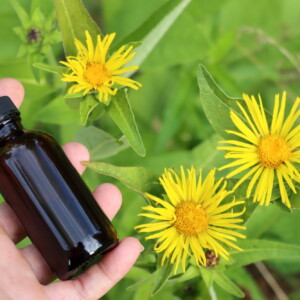
Elecampane Tincture
Equipment
Ingredients
- Dried Elecampane Root
- Neutral Spirit such as vodka*
Instructions
- Start by filling a clean mason jar with freshly chopped elecampane root or dried root pieces. If you're using fresh root, fill the jar about halfway; for dried root, fill it about one-third of the way. Fresh roots release moisture, so be sure not to pack the jar too tightly to allow for proper extraction.
- Pour your chosen alcohol (typically vodka, though brandy or rum can be used) into the jar, making sure the elecampane root is fully submerged. The alcohol should completely cover the plant material. You want to ensure that the root is entirely covered to prevent any mold or bacteria from forming. The alcohol should be at least 60-proof to ensure proper preservation.
- Close the jar tightly with a lid and shake gently to mix the alcohol with the root. Store the jar in a cool, dark location for the extraction process to begin. A cupboard or pantry away from light and direct heat is ideal.
- Over the next 4 to 6 weeks, shake the jar every few days. This helps keep the root material evenly distributed in the alcohol, ensuring that the tincture extracts as much medicinal goodness as possible. If you’re using fresh root, it might float to the top, so you may need to top up the alcohol to keep the root submerged.
- After 4 to 6 weeks, strain the tincture using a fine mesh strainer or cheesecloth over a funnel, and transfer the liquid into a dark amber glass bottle. Make sure to press the root material gently to extract all the liquid from the plant. Discard the root material once the tincture has been fully strained.
- Label your tincture with the date it was made, the ingredients, and the recommended dosage. Store the finished tincture in a cool, dark place to maintain its potency. The dark glass bottle helps protect it from light and ensures it remains effective for longer.
Notes
Expected Yield
Fresh elecampane root will release more moisture into the alcohol during the extraction process, so you may end up with slightly more tincture than the amount of alcohol you started with. Dried root will absorb some of the alcohol, yielding a little less than the initial amount. A quart jar typically requires 2 to 3 cups of alcohol, or 1 to 1.5 cups for a pint jar. Always make sure the plant material stays fully submerged to avoid spoilage.Alcohol-Free Glycerite Option
For those who prefer an alcohol-free option, you can make a glycerite tincture by using vegetable glycerin instead of alcohol. Simply cover the dried or fresh elecampane root with a 3:1 mixture of glycerin to distilled water. If you're using fresh root, you can use all glycerin and skip the water. As with the alcohol tincture, shake the jar daily and strain it after 6 to 8 weeks.Disclaimer on Homemade Herbal Remedies
I’ve been foraging wild medicines and treating my family with herbal remedies for the past 20 years, but I’m self-taught. Be aware that I am not a clinical herbalist, and this is based on my own research and personal experience using medicinal plants. I do not claim to have the experience that’d qualify me to advise you on your health, and I’m only providing this as a reference to encourage a broader interest in medicinal plants.
Please use this as a jumping-off point, but always do your own research and verify anything you read with multiple sources.
It’s always possible to have an adverse reaction to any medicinal herb, and plenty of people are allergic to even gentle herbs like chamomile. Always consult your doctor or a certified herbalist before trying any new medicinal plant. Often, they can have unintended reactions in combination with other herbs and supplements, and many herbs have side effects even when they are effective for their intended purpose.
If you are seriously interested in herbal medicine, I’d suggest investing in a course in herbal medicine, and I’d recommend any of the online courses put out by the Herbal Academy of New England. Specifically, the introduction to herbal medicine course and the family herbalist group of courses.
They also have a mushroom course, covering both medicinal and edible mushrooms, and a Botany and Wildcrafting Course. I’ve taken both and they’re informative, inspiring, and artfully presented.
Herbal Tinctures
Interested in making other homemade herbal tinctures?
- Crampbark Tincture
- Chickweed Tincture
- Elderberry Tincture
- Dandelion Tincture
- Burdock Tincture
- Echinacea Tincture
Herbal Medicine Making
Herbal medicines don’t stop at tinctures! Learn how to make more homemade medicine…
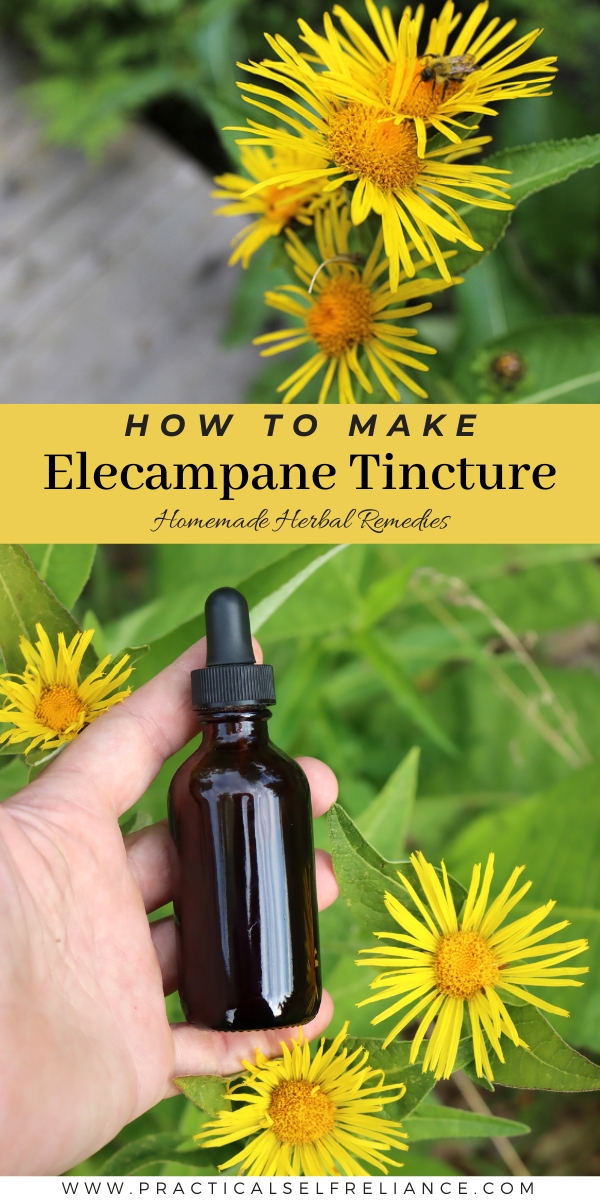
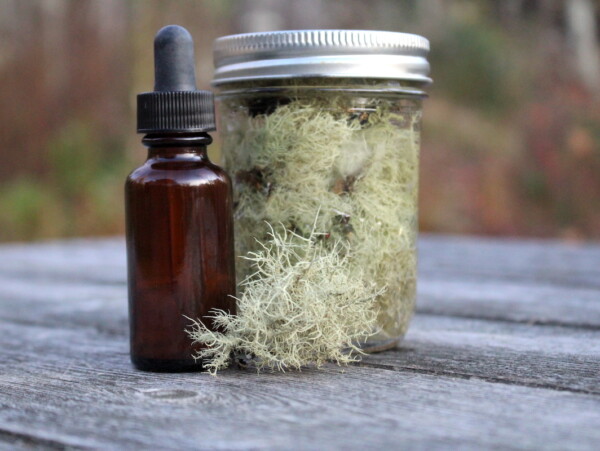
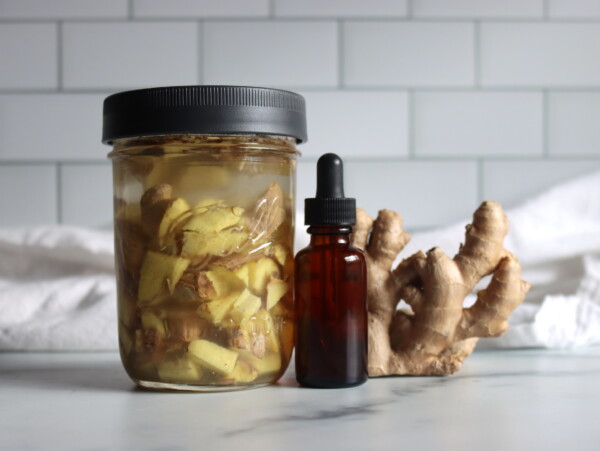
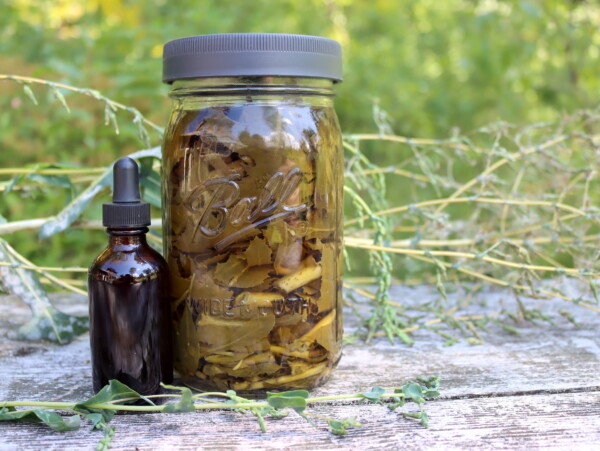
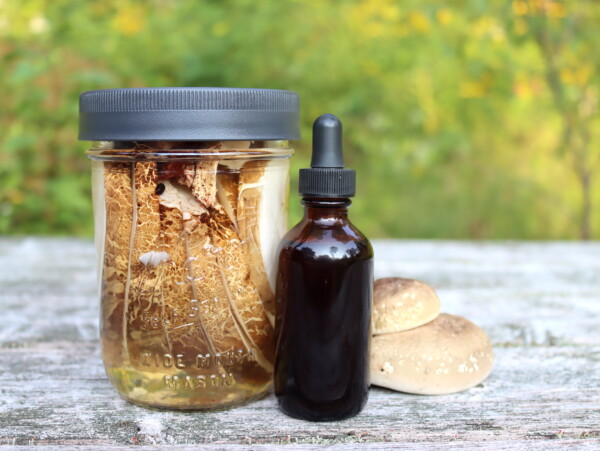










This, along with thyme tincture, is my favorite home remedy for cough and respiratory issues.